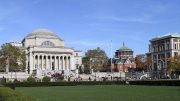Public higher education in the border area of Texas has improved in myriad ways.
It began with a lawsuit by the Mexican American Legal Defense and Educational Fund (MALDEF) in 1987.
The Texas border area, including the area from Brownsville to Corpus Christi to San Antonio to El Paso, with 20 percent of Texas population, has improved from 11 percent of Texas higher education revenues in 1993 to 18 percent in 2013, and remains at 18 percent today. The area has gone from three doctoral programs in 1993 to 65 doctoral programs in 2016. And state average revenues per university student went from 70 percent in 1993 to 95 percent in 2016.
Most important, the border has 70 percent more students attending higher quality and more comprehensive universities in 2016 than in 1993.
These improvements — the greatest leap in Texas history in higher education offerings in a state area — have led to greater opportunities for students, more focus on community issues and a very rapid increase in the economic and development effects of the universities on their communities and the state.
MALDEF filed the LULAC v. Richards lawsuit in 1987.
It represented the League of Latin American Citizens (LULAC), the Texas GI Forum, the Texas Association of Chicanos in Higher Education, other Latino organizations, and 25 students. They challenged decades of discrimination against Mexican-Americans in the border area.
Until the 1970s, San Antonio was the largest city in the United States without a public university.
The entire border area was — and remains — the largest and most populous area in the United States without a comprehensive university offering a wide variety of doctoral and professional programs. UT Austin, Texas A&M, the University of Houston, Texas Tech and even UT Dallas, UT Arlington and the University of North Texas have significantly more.
On average, students in the border area traveled 225 miles to attend a comprehensive public university, while students in the rest of Texas traveled only 45 miles. So only 20 percent of border students, but 60 percent of the students in the rest of Texas, attended a comprehensive university.
Commerce, Denton, Lubbock, Nacogdoches and other small Texas cities each had more doctoral programs than the entire border area. The University of Texas at Austin and Texas A&M University each had more programs and a larger budget than all higher education institutions at the border.
There were no doctoral programs — even in international trade and Spanish — in existing universities in El Paso, Laredo, Edinburg or Brownsville. But College Station, Austin, Denton and Commerce did have such programs.
So, why do all these statistics matter?
Doctoral and professional programs represent superior quality of faculty, research laboratories, libraries, and employment opportunities for students.
Doctoral and professional programs reflect a much broader, higher quality and respected educational program at all levels. The border now has twice as many students attending a public university and those students are attending higher quality institutions.
And more comprehensive higher education programs are a major factor in attracting white collar jobs and high-tech businesses in general.
At the trial in 1991, Henry Cisneros testified that San Antonio competed with cities around the United States to attract the national computer research center SEMATECH (a consortium of universities, computer manufacturers and the U.S. government) to San Antonio in the late 1980s, but lost the competition to Austin because of the far superior higher education opportunities in Austin.
Concentrations of higher education programs have been the catalyst for the international high-tech centers in the Silicon Valley, Route 128 firms in Boston, and the research triangle firms in North Carolina.
Students in all the large and medium-size communities in Texas outside the border could live at home and attend a comprehensive university. Students in the border could not afford to move and attend these institutions, but were relegated to attend the less resourced universities in their areas.
The MALDEF lawsuit was one important cause for this improvement in higher education. Why was a lawsuit necessary to do this?
Unfortunately, in Texas, changes in state systems in public education, higher education, prisons, mental health, and child welfare require a lawsuit to break through decades of neglect. They serve to focus public and governmental attention.
For generations, Texas’ misguided leaders assumed the border area was not ready for the highest levels of education. They were focused only on getting students out of high school and into the workplace. This assumption was ironic because the state didn’t support efforts to educate the state’s students in public education either. This neglect has led to many of the educational and social crises we confront today.
To force an improvement in the unconstitutional funding of higher education in Texas, MALDEF won a court order requiring Texas to improve border higher education.
That year, MALDEF and Texas Rural Legal Aid — now called Texas Rio Grande Legal Aid — worked with community leaders, legislators, and experts to develop a plan for higher education in the border, with specific programs and funding recommended for the border universities in San Antonio, Corpus Christi, Kingsville, Brownsville, Edinburg, Laredo, Alpine and El Paso.
All the border area state senators and representatives, as well as the community leaders from the border cities, signed on to this comprehensive plan to improve the universities at the border. This unanimous support led to legislation passed in 1993 that created UTSA downtown, Texas A & M International University in Laredo, full four-year universities for the first time in Brownsville and Corpus Christi, rapid expansion of masters and doctoral programs, and new buildings and scholarship opportunities.
The 1993 legislation was the seed for vast improvement in higher education throughout the region. The border region representatives recommended the creation of a medical school in both the Valley and in El Paso. The medical school in the Valley did not become a reality until 2015, while El Paso has yet to develop its new medical-related programs into a full medical school.
After the Texas Legislature passed this new significant funding for the border universities, the Texas Supreme Court reversed the underlying lawsuit, though the court acknowledged the inferior funding of the border universities and the significant new investments made in the 1993 Legislature.
In 1993, all the universities in the border area were in the lowest two of five tiers of higher education. Now we have several universities in the second and third highest tiers, a nationally recognized and respected improvement.
What should be our focus for the future?
The border community must lead in efforts to improve the region’s universities and education in general to the levels attained in the rest of the state.
UTSA and UT El Paso should reach top tier status.
We should support continued development of the medical school in the Valley and an additional medical school in El Paso.
We should work to improve the universities in Corpus Christi, Kingsville and Laredo to offer a much greater range of doctoral and specialized programs focused on their special expertise in coastal and border issues, as well as education and business.
And we must increase state funding. Much of the increase in funding in Texas higher education has come from increases in tuition, rather than direct state funding. This puts great financial strain on students and their families, and discourages the low-income community from accessing higher education, which is the best ticket to progress for families.
The border area, long relegated to the lowest tiers of Texas higher education, should be funded at a level to recognize the unique opportunities and challenges of the region.
At least 5 million people reside in Mexico within 10 miles of the Texas border. This population, as well as the billions of dollars of economic activity on the Mexican side of the border area, has direct effects on Texas border communities.
We must enhance our higher education resources in the border area to study and interact. We must recommend policies to deal with these international issues. And most important, we must give our children a fair chance at education at all levels.
Al Kauffman, one of the attorneys for MALDEF in the LULAC case, is a professor at St. Mary’s University School of Law. The detailed study from which this article was excerpted will be published in the October 2016 Journal of Law and Education.
Please visit the source link below to read the entire article.
Source: www.mysanantonio.com




